Mexican Ex-Votos
Leaving token gifts of thanks for the gods is as ancient as human civilization. These so-called ex-votos (from the Latin words “from a vow”) take many shapes and forms from molded wax images of healed body parts to baby shoes from grateful mothers to model boats from shipwreck survivors to mass-produced metal talismans with symbolic representations of answered prayers .
Votive paintings seem to have originated in Italy and came to the New World with the Spanish conquistadors in the 16th century. These artistic expressions of gratitude to the Christian God found echoes in Aztec votive rituals and were quickly adopted by the mission churches of Mexico. When tin plate became widely available in the early 19th century, ex-votos painted on metal proved affordable even for the poor. Devotional images, commemorating healings and other divine interventions in human affairs, soon spread across Mexico and remain popular to this day.
Traditional tin-plate ex-votos have three basic components. There is an image of Jesus, the Virgin Mary or a favorite saint, enshrined or hovering in the upper part of the panel in clouds or a circle. If ex-voto donors have money the painting might depict the miraculous event to be commemorated in the center of the picture (like delivery from a stampeding bull!) Cheaper versions simply show figures, representing the donors, kneeling in prayer. At the bottom of the ex-voto there are always a few lines of text (usually dated, along with the name of the donor and, occasionally, the artist), expressing gratitude to a particular holy intercessor.
Just as illiterate peasants might turn to a village scribe to write them a variation on a form letter, buyers with limited budgets can choose pre-painted panels, which their local ex-voto maker will personalize with the appropriate inscription. The images are, then, presented to parish churches or pilgrim shrines and, usually, nailed in rows along the walls of a side altar.
Ex-votos are not only a unique form of “confessional” art, giving people on the margins of society a public voice; they are also valuable historical artifacts, offering rare glimpses into the private worlds of ordinary people. Two genuine ex-votos in the Sacred Art Pilgrim Collection have harrowing tales to tell in image and word about the turbulent years, following the Mexican Revolution of 1910, when a series of anti-clerical governments placed restrictions on church life and marauding militia groups terrorized rural communities.
To Our Lord of Mercy (1919), gives a detailed description of just such an event on October 10, 1919, when Julian Arreguin was captured by an armed band and accused of “slander.” He was freed at the same moment his wife and father sought help from "Our Lord of Mercy." They commissioned the ex-voto with “the most infinite thanks for such a rare wonder.” A second tin plate, dating from January 1921, To Our Lord of Mercy (1921), shows a man, rounded up by soldiers in Bolshevik-style dress, who was released through the prayers of the woman, kneeling at the crucifix.
Tin-plate devotional paintings were not considered to have much aesthetic worth until they were discovered by 20th century Mexican arts like Muralist Diego Riviero and his wife, Frida Kahlo, who made one ex-voto-styled painting in 1940, recalling the trolley accident in her youth, which left her disabled. Nowadays, the demand for vintage panels among folk art collectors is so great it has inspired a cottage industry in hand-made reproductions, appropriately aged, as well as “fake” originals (based more on the fantasies of the painters than on reputed miracles!)
Two panels in the collection, which appear to be genuine, offer thanks to Father Jesus for a good harvest and express gratitude to St. Francis for deliverance from a flash flood. The remaining ex-votos, mostly reproductions, give thanks to Christ, the Virgin of Guadalupe (a favored recipient of ex-votos), the Holy Child of Atocha, St. Martin de Porres and other holy intercessors for the healing of family members with stomach ailments, release from an American prison, and for delivery from the World Trade Center disaster. In one panel, the donor expresses thanks for being chosen to play Christ in a village Easter pageant.
The ex-votos recounting a wondrous event at a professional wrestling match and the appearance of helpful wild animals on a farm after a hurricane, probably, have no basis in reality, however delightful these pieces might be as contemporary folk art!
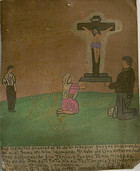
To Our Lord of Miracles

To Our Lord of Mercy (1919)

To Our Lord of Mercy (1921)
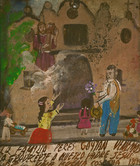
To Father Jesus
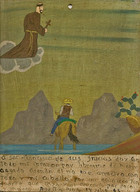
To St. Francis
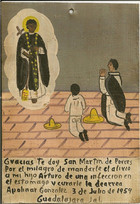
To St. Martin de Porres
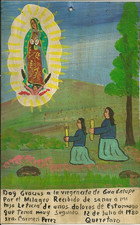
To the Virgin of Guadalupe

To the Holy Child of Atocha
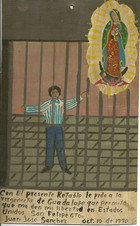
To the Virgin of Guadalupe
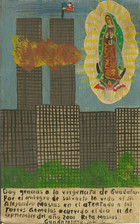
To the Virgin of Guadalupe

To the Crucified Christ
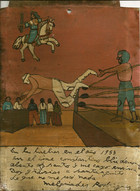
To Santiago

